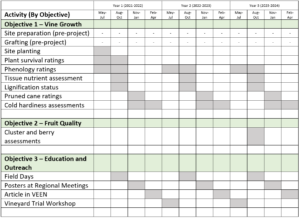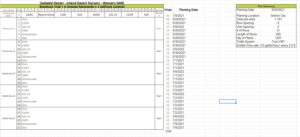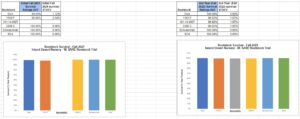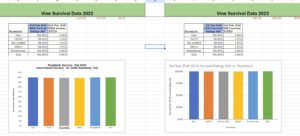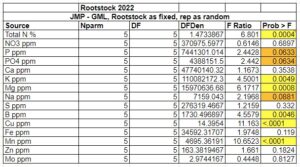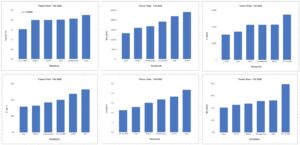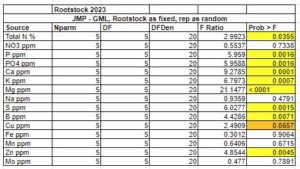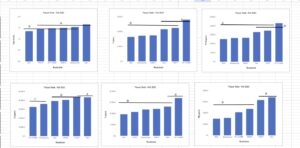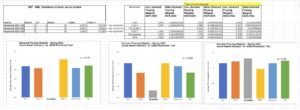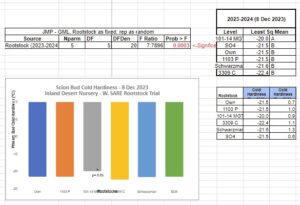Final report for FW21-373
Project Information
Washington State is the second-largest wine grape producing region in the United States, with nearly 60,000 acres of “self-rooted” Vitis vinifera in the Columbia Valley. Contrarily, wine grapes worldwide have been produced using vinifera grafted onto rootstocks tolerant of devastating soilborne pests, such as phylloxera (Daktulosphaira vitifoliae) and parasitic nematodes, as well as to mitigate abiotic stressors.
Washington vineyards were first established in land mostly absent of significant populations of phylloxera and nematodes. The next greatest production challenge defaulted to cold injury; vinifera are more cold-sensitive than rootstock varieties. If a self-rooted vine is injured, new growth from the trunk and root system is retrained back to the trellis. If the scion of a grafted vine is injured, the healthy rootstock either needs to be regrafted or replanted, incurring costs that historically outweigh the benefits.
Parasitic nematodes have since established, and in 2019 and 2020, significant pockets of phylloxera were discovered across Columbia Valley vineyards. The only management solution for phylloxera is rootstock use. However, limited knowledge of rootstock characteristics in the Columbia Valley has caused a risk barrier in selection and adoption among producers. This project aims to “take the plunge” by planting a grafted demonstration vineyard where stakeholders can see and learn about establishing, growing and thriving with rootstocks. Through our results, which will be presented at industry field days, meetings and media outlets, producers will be prepared with applicable knowledge on how to select rootstocks for sustainable future wine grape production in the Columbia Valley.
- Evaluate different grapevine rootstock cultivars to determine which have the most promise for Washington wine grape producers in terms of growth, nutrient, and hardiness characteristics. (Years 1- 3).
- Determine how different rootstock cultivars influence scion fruit characteristics, such as cluster weights, berry size, brix, titratable acidity (TA) and pH. (Year 3).
- Develop demonstration trials and deliver rootstock evaluation results to wine grape producers to promote rootstock adoption for sustainable future vineyard plantings (Years 2-3).
Cooperators
- - Technical Advisor
Research
The research plan has two main objectives:
- Evaluate different grapevine rootstock cultivars to determine which have the most promise for Washington wine grape producers in terms of growth, nutrient, and hardiness characteristics. (Years 1- 3).
- Determine how different rootstock cultivars influence scion fruit characteristics, such as cluster weights, berry size, brix, titratable acidity (TA) and pH. (Year 3).
Trial Establishment. This research is being conducted at Inland Desert Nursery in Benton City, WA on a 1.1-acre demonstration vineyard that we chose because of known phylloxera pressure nearby, uniform topography and soil type (classified as a Starbuck silt loam with 0- to 5% slopes) and proximity to our farming headquarters for proper oversight and ease of customer touring. Before planting, we collected soil samples to quantify nematodes, chemistry/nutrients, and biology. Fertilizer was added before planting to correct any soil deficiencies, with formulations and amounts documented. One representative field soil test was taken to quantify nematode, nutrient/chemistry and biology levels of the whole field, for the purposes of assessing the effectiveness of inputs, comparing with leaf nutrient values, and monitoring nematode population progression over time. (See in Links 1 and 2)
Link 1: RM5 WSDA Soil nematode negative Xiphinema (1) Link 2: RM5 Soil Nutrient Tests 2021 (1)
Rows were oriented North to South. Cabernet Sauvignon was planted on the western edge of the vineyard due to having 1 extra row that could not contribute to the other 5 trial replications. Therefore, we chose another common Washington State planted variety for grower interest/education, using a “salad bar” method of various rootstocks down the same row so vigor and resistance differences could easily be spotted when looking down a single row. Another side benefit to choosing a red cultivar on the outer edge of the block is that it will act as an early indicator for the presence of leaf roll infection from neighboring vineyards. The majority of the trial block was planted to 5 replications of Chardonnay Clone 15. Chardonnay-15 was chosen as the primary scion for analysis because it was a high in-demand variety in Washington State at the time of planting, and this particular clone has been widely farmed with standardized canopy management and growth practices, allowing our farmer-customers the ability to relate to the self-rooted version while analyzing the differences influenced by the various rootstocks chosen. Our Chardonnay-15 was grafted to the following five rootstocks: 1103 Paulsen (1103P), 101-14 Millardet Et De Grasset (101-14), 3309 Couderc (3309), Schwarzman, and SO4/Oppenheim #4 (SO4), and a sixth self-rooted “control” was also used (to which all performance characteristics will be evaluated against). All the non-vinifera rootstocks have high tolerance to phylloxera and some degree of tolerance to parasitic nematodes (Table 1). The trial was planted out in a replicated (5 replicates) block design. Randomization of the rootstocks were not to be implemented within each of the block replicates for ease of long-term tracking and management of the rootstocks (e.g., for potential future trials). Figure 1 shows a visual layout of the vineyard planting design; total vines planted will amount to 1,252, with roughly 200 vines per self-rooted or rootstock/scion combination treatments. After planting, the vineyard was maintained with industry standard integrated pest management and horticultural practices. The vineyard was planted using green growing, potted vines finished at 12 inches in length. All propagative material came from hardwood cuttings from Washington State Department of Agriculture certified mother blocks. Scion and rootstock combinations were “bench-grafted” in close succession using an omega-shaped graft punch. Grafts and cuttings underwent callusing in a controlled environment to heal and protect pruning wounds and the graft union. Once vines were adequately callused, both grafts and self-rooted control treatments were grown in pots in a controlled climate greenhouse, and the most uniform resulting plants were selected for planting in the demonstration/research vineyard. The majority of the specified trial vines were planted in June 2021 utilizing protective vine shelters, resulting in a 99.5% success rate. 278 vines are left to complete the trial planting in the Spring of 2022 as a result of short nursery material on 101-14 rootstock. Planting records confirming the 2021 grapevines are shown below in Figure 2- l. The same vine format, farming process and procedures were used to complete the block in the Spring of 2022.
Objective 1: Rootstock performance evaluations. After June 2021 planting, we began collecting data for Objective 1. To understand how rootstocks will contribute to establishment success, we documented a survival rate of 99.5% across all combinations in the Fall of 2021, just prior to dormancy (See Figure 2.). We were surprised to see such a high survival rate given the extreme temperatures during the time of planting (a peak of 116 degrees, and a full month of +100 degrees). From 2022 to 2023, we saw little difference in the survival ratings. (See Figure 2a.)
To understand how growth was influenced, the following phenology ratings and measurements were to be taken annually: 1) phenological growth stage in May, July, and September; 2) tissue tests for nutrient status at véraison; and 3) weight, average diameter, length, and number of buds on pruned canes collected from November through February (dormant pruning). All measurements were collected from a minimum of 4 plants in each treatment replication. Phenology was rated on 6 buds/shoots per plant (a basal, proximal, and distal shoot relative to the vine trunk on each establishing cordon of the vine), for 4 vines per treatment replicate. To assess the impact of the rootstock/scion combinations on vine cold hardiness, we measured the lignification progress of flag shoots every week from August through mid-October. We updated the minimum quantity of plants to 4 from 10, as it was determined that a sample size of 4 would still yield statistically significant analysis and was more achievable to conduct.
As would be expected given the early age-stage of the vines 2021 phenology ratings and vine measurements were deferred to 2022, as vine growth was limited and not showing any material differences across the replications. However, we expect to complete the full scope of activities listed above for the 2022 planting year and beyond, as the grapevines will be waking up for a full cycle of growth and shut-down together. As would be expected given the early age-stage of the vines 2021 phenology ratings and vine measurements were deferred to 2022, as vine growth was limited and not showing any material differences across the replications. Unfortunately, due to labor shortages and limited insights to gather at this vine stage, we decided to only collect a single phenology rating in April of 2022. (See Figure 3) Based on the averages of this single phenology sample, the 1103P treatment replication advanced from dormancy slightly earlier than the others. In 2023, we were able to collect phenology ratings on all replications from around Bud Break to after Cane Harvest. Based on the phenology ratings, there were slight differences in the shoot and inflorescence development stage. However from Lag Phase til the end of the season, all replications showed similar growth patterns. (See Figure 3a. - Excel Spreadsheet)
For the nutrient tissue tests, we used the ANOVA statistical test to help measure the differences of nutrient uptake between the different treatment replications. (See Figures 4, 4a.) For 2022, there were measurable differences between the trial rootstock combinations in coordination with nutrient uptake. In Figure 4, the values highlighted in yellow show the highest statistical difference between the trial rootstocks and their nutrient uptake levels, values highlighted in orange show marginal differences. We can see these differences in Figure 4a. In 2023, there were even more measurable differences between the trial rootstocks and their nutrient uptake levels, significant values are highlighted in yellow, marginal differences highlighted in orange. (See Figure 4b.) We can see these differences in Figure 4c. This is where things got interesting. If certain rootstocks can uptake different nutrients better than others, this could benefit grape growers where the soil is deficient in these nutrients, and could help them take advantage of certain fertilizer application. However, we will need to collect more data points in order to become confident in this hypothesis.
As seen in Figure 5, in 2022, the 3309C Treatment Replication weights have been slightly higher than the others. We expected low pruning weights for 101-14 MGT replications in 2022 as planting was only completed in Spring 2022. We decided not to take the diameter length and number of buds as the pruning weights were enough to interpret a growth pattern between the different replications. In 2023, we saw a shift as the vines were in their second year of growth, with the exception of 101-14 MGT, as it was the first year for that replication. All across the board the pruning weights were higher than the previous year. In 2024, no significant differences were found.
In addition to the completed survival ratings, Dr. Moyer’s laboratory conducted cold hardiness tests using differential thermal analysis (DTA) to establish temperatures that produce an LT50 (http://wine.wsu.edu/extension/weather/cold-hardiness/). These samples were collected during the transitional time periods of early November (2 sampling periods) and late February (2 sampling periods). You can see the data for the DTA Testing in Figure 6 and Data for Objective 1 needs to be collected over a three-year time span to understand if characteristics imparted by the rootstocks to the scion are volatile or consistent over time.
Figure 3: 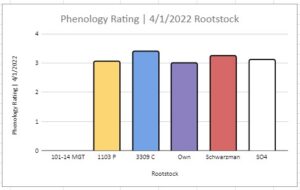 Figure 3a: Phenology Ratings 2023
Figure 3a: Phenology Ratings 2023
Objective 2: Impact of rootstock on scion fruit quality. Objective 2 was achieved by measuring fruit before and at harvest in 2023. Fruit produced in prior years was inconsistent and unlikely to produce significant results due to immaturity of the plants. In harvest 2023, unforeseen personnel changes affected our ability to collect the data for Objective 2. We will continue to monitor the production and quality of the block in the next few years. We also believe that through our data and outreach in objectives 2 and 3, we have successfully addressed the viticultural basis of performance between these rootstocks. We look to continue investigating the oenological impact of these differences in how they would impact wineries in regard to the quality of wine capable of being produced.
All data will be subjected to an Analysis of Variance and subsequent means separation using Tukey’s HSD.
Table 1. Rootstock Characteristic Chart
Figure 1. Demo Vineyard Design
Objective 1: Rootstock performance evaluations- Survival Ratings: We found that altogether, all vines had a similar establishment success rate despite being planted in 116°F weather and below freezing temperatures, thanks to grafted vine protocols (Burying the scion for the winter, unbury in the spring) and appropriate irrigation adjustments. (See Survival Ratings Above)
Phenology Ratings, Nutrient Tissue Tests: Through phenology ratings, tissue tests, and pruning weights we noticed a fairly similar growth pattern, where self-rooted vines and grafted vines seemed to have the same growth patterns. There was one difference that we noticed was through the nutrient tissue tests. Different rootstocks would uptake certain nutrients better than others over the last two years. (Please see Figures 4- 4c) If we can prove that different rootstocks can uptake different nutrients better than others, it could benefit grape growers who have grow sites deficient in these nutrients. This could also help growers take advantage of certain fertilizer applications. However, we will be collecting more data points in the future to become more confident in this hypothesis.
Pruning Weights: With pruning weights,(see pruning weights above) we found no differences between the self-rooted vines and the different grafted vines, which proved that there is not much of a difference between the two.Objective 2: Impact of rootstock on scion fruit quality. Unfortunately, due to grapevines not reaching full production until their 3rd year, and the personnel changes we had in 2023, we were unable to collect the data we needed for Objective 2. However, we will continue to take data for objective 2 in the coming years.
Research Outcomes
Different Rootstocks have different characteristics. Finding the one that best suits WA State with the discovery of phylloxera should help create longer lasting vineyards. While Rootstocks have been in use throughout several other major growing areas of the world, Washington has not had the same level of large scale research to reflect its unique location especially in the presence of phylloxera. Throughout our research, we discovered that the prevailing reasoning for not using grafted vines due to cold tolerance was not inherently necessary. Through hilling above the scion in the winter time and de-hilling during the warmer months, the survival ratings of grafted vines vs. self-rooted vines were the same (See Figures 2 and 2a.) grafted vines are just as hardy as self-rooted, with the difference that rootstocks are resistant to certain pests that have very little to no solution of elimination, through chemical or otherwise. Because of this resistance, grafted vines will be able to stay in production for a longer amount of time than self-rooted vines. As for the cold-hardiness results, there were little to no differences between the various rootstock combinations. This proved that the rootstocks do not have control over the scion's fruiting bud survivability, but it depends on the varieties of the scion. Replanting a vineyard is a labor intensive cost; therefore, anything that can prolong the production and sustainability of a vineyard is beneficial to the grower.
Another interesting factor that we found through our research were the results of the nutrient tissue tests over the past couple of years. When looking at the data (See Figures 4, 4a-4c above) certain rootstocks seemed to be able to uptake specific nutrients better than others. Unfortunately, we don't have enough data points to say with confidence that different rootstocks are better than others with certain nutrient uptakes, and would like to look into this more as a future study. If this hypothesis is correct, it could be beneficial for growers who have vineyard sites lacking in these nutrients, or be able to make decisions that would make fertilizer applications more effective.
Education and Outreach
Participation Summary:
Events and Outreach 2021/2022/2023
Education and outreach description
Describe the activities indicated above as well as outreach in progress (e.g. newsletter, journal articles, upcoming presentations, etc.).
- Washington State Grape Society Conference Nov.18-19th 2021
- Presentation on our Rootstock Trial- A Nursery Overview and a reflection of the grape growing industry, and how it has changed since 2015. What Rootstocks we offer.
- Overview of our Western SARE Rootstock Trial for Washington State:
- What SARE is
- How our research plot is set up for both Chardonnay and Cabernet Sauvignon grafted onto Self-rooted, 1103P, 101-14, 3309C, Schwarzman, and S04 rootstock. Explaining the different characteristics for the most popular rootstock varieties there are in Washington State.
- Gantt Chart on our research and outreach timeline. Future Field Days and Conferences to be determined by WSU. - With one expecting to take place in May/June.
- Around 250 Farmers/Ranchers and Agricultural Professionals were in attendance.
- Good Fruit Growers Article Jan. 26th 2022
- How important the rootstock trial is in the face of the recent discovery of Phylloxera in the area. This will affect how grape growers farm their vineyards and inform them on important grafting decisions and what rootstock will perform the best against Phylloxera.
- Inland Desert expanding their rootstock motherblocks and how this trial will affect the future of the Grape Industry.
- Washington Grape Growers Association WineVit Conference Feb. 7th-10th 2022
- Poster detailing an overview of the Western SARE Rootstock Trial, Research Focus, and advertising of future Field Day Tours and hosting at least 2 workshops in the summers of 2022 and 2023.
- Poster won 2nd place in professionalism out of 12 posters registered.
- Total attendance of the event was 750.
- Spanish Speaking Leadership Seminar Mar. 2nd 2022
- 2023 WineVit Poster en Español
- Presentation on Grafting and Rootstocks. - What it is and what it does.
- How it will affect vineyard decisions.
- Explaining the Rootstock Trial and what it means for future grape growing trends.
- Total Attendance: Roughly 85 Grape Growing Professionals.
- VEEN Article- Spring 2022
- Advertised our Field Day/Workshop.
- Advertised Rootstock Trials.
- Field Day/Workshop July 15th 2022
- Explained our Rootstock Trial. How it was organized, what we are looking to achieve.
- Why rootstock trials are important to Washington State's Grape Growing Industry.
- Tour of the Trial Block.
- How to create your own rootstock trial.-What you will need.
- Total Attendance: 26
- 2022-Rootstock Field Day - Survey Responses
- Good Fruit Growers Article Nov. 15th 2022
- Update on the Rootstock Trial.
- What industry leaders have to say on grafted vines and rootstocks in Washington State.
- What the industry expects from the trial.
- Field Day/ Workshop July 13th, 2023
- 2023-7-Roostock Field Day Agenda
- Went over Rootstock Selection and Choice.
- What it takes to Designing (Rootstock) Field Trials.
- What worked and what didn't work for Inland Desert Nursery when designing this trial.
- Worked in individual teams of three, had groups design their own roostock trial with:
- What questions they wanted to answer.
- Where they wanted to plant.
- What roostocks they wanted to try.
- Trial Designs were reviewed and discussed to highlight best practices and possible shortcomings.
- Gave advice on how best to protect grafted vines from cold damage.
- Walk-through the rootstock trial block, answered questions, and shared what we have learned about the different rootstock during the establishment period.
- Total Attendance: 27
- 2023-Rootstock Field Day - Survey Summary
- Washington State Grape Society Conference November 16-17th, 2023
- 2023 Rootstocks102 Poster
- Explained how to take care of your grafted vines up receiving them.
- How to plant grafted vines.
- Why they are the future of Washington State's grape industry.
- 2023 Rootstocks102 Poster
- Consultations:
- Meetings between Sarah Del Moro, Robert Cook, Dawson Daniels, Michelle Moyer, and Kevin Judkins have resulted in what our testing parameters will be, organizing workflow.
- Michelle Moyer from WSU and her team have and will continue to measure the cold hardiness of the buds as time goes on.
- Inland Desert Nursery, Dawson Daniels, Sarah Del Moro will keep track of Survival Ratings, Nutrient Tissue Testing, Phenology Ratings, and Pruning Weights.
- How we will measure the Phenology Ratings and when we will record all results throughout the year.
- Meetings between Sarah Del Moro, Robert Cook, Dawson Daniels, Michelle Moyer, and Kevin Judkins have resulted in what our testing parameters will be, organizing workflow.
We had major success in our outreach efforts for objective 3. Our presentation during the Washington State Grape Society Conference in 2021 introduced our Trial to 250 large and small grape growers across the state. In this presentation we posed the questions all of Washington’s growers were asking, in light of the discovery of phylloxera in Washington State and what the future of the industry will look like. The Good Fruit Grower Articles in 2022 and the different VEEN advertisements helped to spread the work on our progress and our Field Days past Washington’s Grape Growing regions and attracted other growers from neighboring states. (Please see links above in the Education and Outreach Description section) The same can be said about the posters presented at the Washington Grape Grower Association.
At the Spanish Speaking Leadership Seminar, we were able to tap into a different aspect of the grape community by presenting our trials to non-native english speakers in the industry. This presentation and the accompanying poster was widely popular at the seminar and many of the participants showed great interest in the trial and what it means in the future.
Both Field Days in 2022 and 2023 were successful given the wide variety and amount of growers that participated in these events. By the time the 2023 Workshop came to a close, a majority of large growers were discussing plans to create their own rootstock trials. To this day we work closely with some of these growers, answering questions about the upkeep of grafted vines and how the progress is going on their own trials. (To see responses, please follow links above in the Education and Outreach Description section.)
Education and Outreach Outcomes
Throughout the duration of our rootstock trial, we were able to give growers confidence in the idea of grafted vines as a sustainable solution to the new-found pest problem of phylloxera. We’ve done this by proving to local growers that grafted vines on multiple different kinds of rootstock can survive the cold winters in Washington State, and how the extra benefits of grafted vines can help improve the longevity and productivity of a vineyard. The best way we have been able to do this was from Field Days- where growers were allowed to walk through the trial vineyard and where we could discuss the costs and benefits we had faced during the trial (please see list below). The face-to-face interactions as well as being able to get eyes on the block helped to convince a few major growers to try their hand at planting grafted vines.
The subjects that were discussed on these Field Days were:
- The hilling and dehilling processes during the year to prevent scion death from extremely low temperatures.
- Planting grafted vines in 116°F temperatures along with prolonged irrigation sets gave us great survival ratings.
- Planting phylloxera and nematode resistant rootstock can lead to an increase in longevity of a vineyard where such pests are present, allowing for a decrease in certain pesticide applications.
- How to choose the best rootstock for your vineyard site, as different rootstocks work best in different environments.
Learning the Differences between Rootstocks. How to decide what which rootstock will be best for certain sites.
The differences in taking care of Self-Rooted Vines vs. Grafted.- Hilling and De-hilling for the first 2 years to prevent scion death during the winter. Certain varieties of rootstock could change irrigation management practices.
